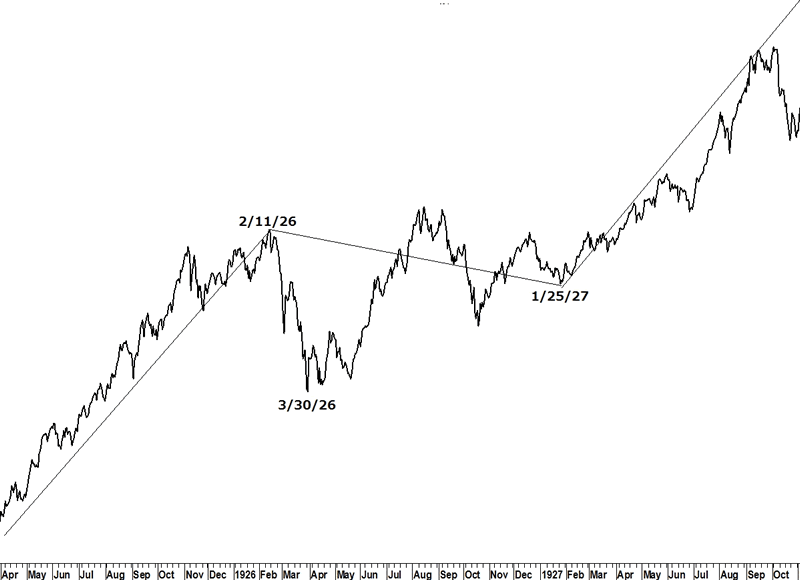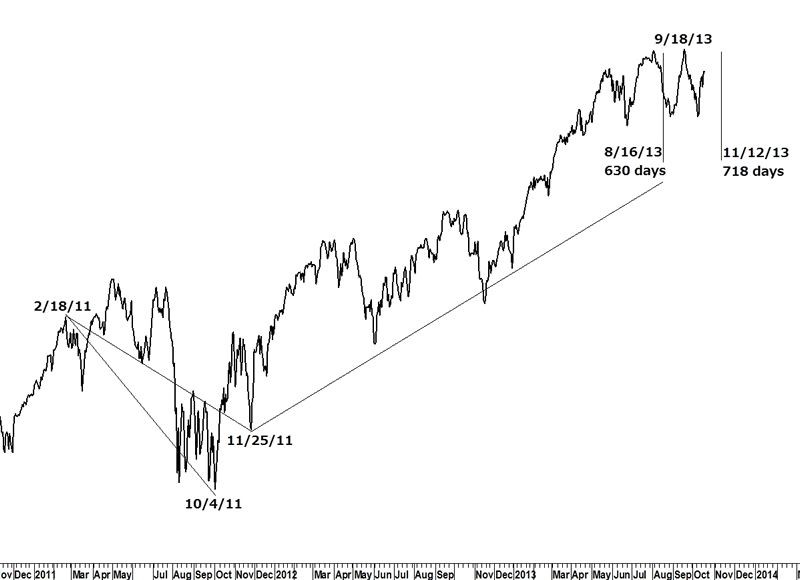New Stock Market High - S&P and Dow Following Separate Paths
Stock-Markets / Stocks Bear Market Oct 23, 2013 - 10:20 AM GMTBy: Ed_Carlson
 The methods of George Lindsay were meant to be applied to the Dow Industrials index and he warned against using these methods on broader indices (S&P 500, Wilshire 5,000, etc.) because of the constant rotation of stocks in and out of the indices and the inclusion of, what he called, "unseasoned issues". But with all major equity indices (DJIA, SPX, and NASDAQ) setting highs on or near 9/18/13 it looked as if the Lindsay forecast for a high in the Dow at that point in time was complete; game-set-match. So what are we to make of new highs in the S&P and NASDAQ since that time?
The methods of George Lindsay were meant to be applied to the Dow Industrials index and he warned against using these methods on broader indices (S&P 500, Wilshire 5,000, etc.) because of the constant rotation of stocks in and out of the indices and the inclusion of, what he called, "unseasoned issues". But with all major equity indices (DJIA, SPX, and NASDAQ) setting highs on or near 9/18/13 it looked as if the Lindsay forecast for a high in the Dow at that point in time was complete; game-set-match. So what are we to make of new highs in the S&P and NASDAQ since that time?
While the major indices typically make their highs and lows together (i.e. 10/11/07 high, 10/4/11 low) the millennium high in the Dow was set on January 14, 2000 but the SPX did not make its final top until March 24 of that year. The methods of Lindsay are not required to see that the Dow and SPX are once again on their own individual trajectories. During the September decline the DJIA violated its August low to print the first lower low since 2011 but SPX continued in its series of higher lows (and now, higher highs).
So why not think the Dow will catch up with the other indices to print new highs, too?
The case for a September top in the Dow was made with the full arsenal of Lindsay tools. It began with a 15year interval (10/28/97) which forecast a top between October 2012 and September 2013.
The Principle of Alternation led us to expect a short basic advance (630-718 days) from the 10/4/11 low as the previous basic advance had been long. The time span of a short basic advance was to expire three days after the 9/18/13 high and seven days before the expiration of the 15year interval. So far, so good.
Any uncertainty is in identifying the beginning of the basic advance. Is the low on 10/4/11 the correct origin? Normally, this would be a simple exercise but in this case the process is complicated by the presence of a Sideways Movement which began on 2/18/11. Without going into an in-depth explanation of Sideways Movements, the best known example is the period from 2/11/26 to 1/25/27 (see George Lindsay Training Course, SeattleTA Press, 2013). Sideways Movements are normally topping formations but in the 1926-1927 instance, the Dow advanced out of the pattern. Lindsay wrote that an advance from a Sideways Movement always leads to a horrific decline in the Dow and that was certainly the case once the basic advance from 1/25/27 concluded on 9/3/29. Lindsay counted the basic advance, not from the ultimate low on 3/30/26 but from the higher low on 1/25/27 using the rationale that it was from the 1927 low that the Dow advanced to higher highs out of the Sideways Movement.

Given that precedent, should we be counting the advance from the 2011 Sideways Movement, not from the ultimate low on 10/4/11, but from the higher low on 11/25/11? One of the most beautiful aspects of Lindsay's work is the fact that his counts often work from various points in time. Taking the count from the 11/25/11 low to the 9/18/13 high is 664 days; a short basic advance (630-718 days). Taking the count from 10/4/11 is 715 days; a short basic advance. Both counts terminate prior to the expiration of the 15year interval on 9/28/13. Given the Dow is still almost 300 points below its September 18 high, I'm inclined to stick to the forecast that the high (in the Dow) of the 2009 bull market was seen on 9/18/13 regardless of what path the other major indices find themselves upon.

It's fair to ask how we will know the forecast was incorrect and what should we expect then. Risk management is one of the advantages of the Lindsay method. Obviously an advance by the Dow to a point higher than the high on 9/18/13 will tell us the forecast was wrong. At that point both the count from the 10/4/11 low and the 15year interval from 1997 will have expired and are of no use. The next 15year interval (9/1/98) won't expire until August 2014 but a basic advance from 11/25/11 gets no such leeway.
Again, the Principle of Alternation tells us to expect (this Principle is a guideline, not a rule) the advance to be short (630-718 days). A short basic advance from 11/25/11 expires on November 12 of this year so an alternative count to a high to the 2009 bull market will expire no later than then.
Request your free copy of the October Lindsay Report at Seattle Technical Advisors.
Ed Carlson, author of George Lindsay and the Art of Technical Analysis, and his new book, George Lindsay's An Aid to Timing is an independent trader, consultant, and Chartered Market Technician (CMT) based in Seattle. Carlson manages the website Seattle Technical Advisors.com, where he publishes daily and weekly commentary. He spent twenty years as a stockbroker and holds an M.B.A. from Wichita State University.
© 2013 Copyright Ed Carlson - All Rights Reserved
Disclaimer: The above is a matter of opinion provided for general information purposes only and is not intended as investment advice. Information and analysis above are derived from sources and utilising methods believed to be reliable, but we cannot accept responsibility for any losses you may incur as a result of this analysis. Individuals should consult with their personal financial advisors.
© 2005-2022 http://www.MarketOracle.co.uk - The Market Oracle is a FREE Daily Financial Markets Analysis & Forecasting online publication.



